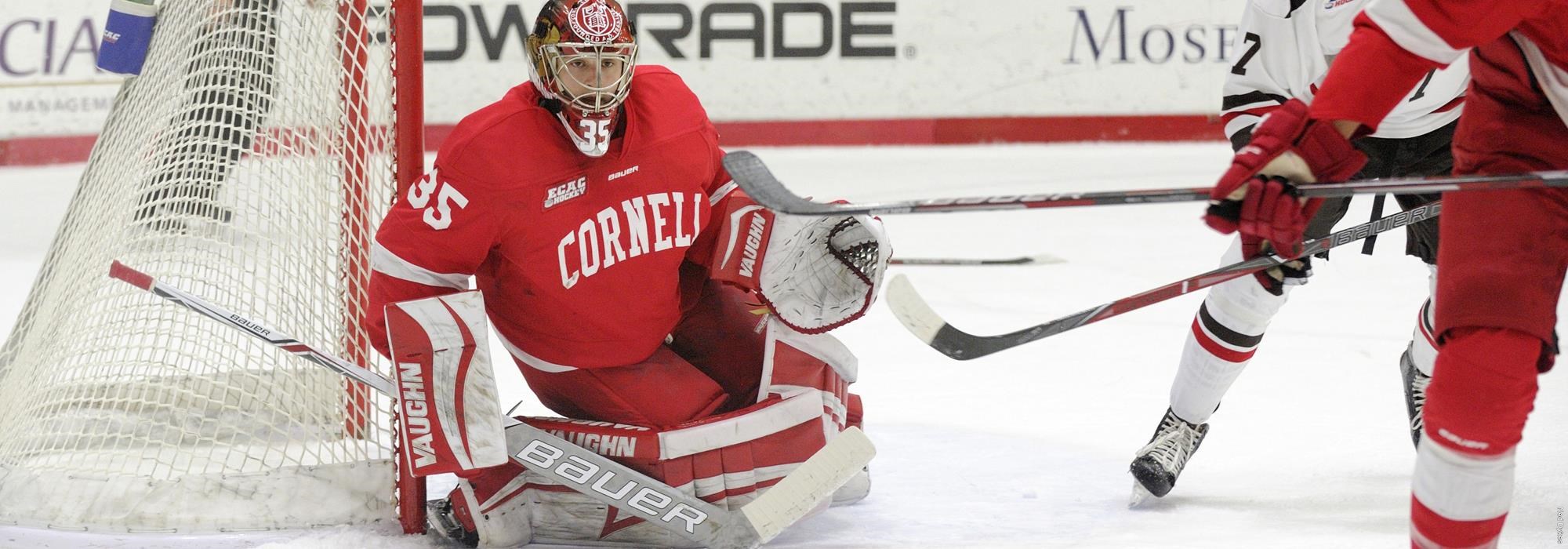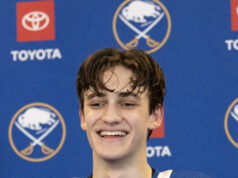ITHACA, N.Y. — In 23 seasons as the Jay R. Bloom ’77 Head Coach of Men’s Hockey, Mike Schafer has never before had his entire defensive corps from one season return for another. Only once before has he had an incumbent All-American goaltender. This season, he has both – and it comes on the heels of the program’s first 25-win season since 2005. Optimism understandably abounds, and so follows an expectation that things will just pick up where they left off. Preseason polls confirm that, with both ECAC Hockey coaches and media anointing Cornell the league favorite, and both national polls tabbing the Big Red seventh among the NCAA’s 60 Division I teams.
The proverbial irony of being in such a spot is that this is a program that, for all its success in 2017-18, never quite got the respect it’s getting now. Sure, the Big Red ascended to No. 1 in the polls and received one of just four No. 1 seeds in NCAA regionals, but the program still never really shed the label of ‘unproven’. Maybe it was because ECAC Hockey as a whole was having a slightly down year. Or maybe it was because Cornell’s non-league schedule was relatively weak. Or maybe it’s because teams with strong defense don’t generate the same buzz as teams with a skill-laden offense. For now, the doubts seem to have subsided.
But this is college hockey, where parity is the norm and unexpected should be expected.
To rest on laurels is a perilous endeavor, and not something to be found at Cornell.
“Thinking that the culture is going to carry over; that the winning attitude is going to carry over; that the process is going to carry over; that the ability to overcome adversity is going to carry over; all of those things – you can’t make that assumption,” Schafer said. “The outside world is going to think what it’s going to think, but within the program we’re starting brand new and have to treat everything that way – from building our chemistry, to building the foundation of the way we play, to keeping our eyes open for different ways to improve. We start right back over again and see where we go.”
Forwards
Senior Mitch Vanderlaan is back as the team’s top returning scorer for a second straight year. He had seven goals and 13 assists for 20 points in a season that was truncated by a six-game absence after he suffered a foot injury while blocking a shot – an injury befitting of one of the three finalists for the 2018 ECAC Hockey Best Defensive Forward Award. With 67 career points, Vanderlaan is also within striking distance of 100 for his career – a threshold not crossed within the program since Riley Nash, Colin Greening ’10 and Blake Gallagher ’10 all did it during the 2009-10 season.
“We say it all the time to offensive-type players: The higher you go up the food chain in hockey – from college to minor pro; from minor pro to the NHL –
it becomes increasingly difficult to score and produce,” Schafer said. “So your effort has to be great on every shift, and you have to be able to score in different ways – rebounds, broken plays, tip-ins, great shots from the slot, whatever it may be. So because Mitch has great effort, it gives him a different chance to score on every shift, because you know that he’s going to lay it on the line.”
Four of last season’s top 12 forwards in games played either graduated (Jared Fiegl, Alex Rauter and Trevor Yates) or departed (Anthony Angello, who signed with the NHL’s Pittsburgh Penguins). That group accounted for 40 percent of the Big Red’s goals a season ago, and 50 percent of its power-play goals. Furthermore, those four had distinctly different roles and typically played on separate lines.
But, as Schafer points out, that’s what you should expect. Seniors are typically leaned on heavily in key situations, of which Cornell had plenty last season. Replacing the departed is an annual occurrence, and it just so happens that – aside from the backup goaltending role – the entirety of that exercise this year for the Big Red is among the forwards. The cupboard is far from bare.
“I think a lot of those guys scored goals early for us, which was key,” Schafer said. “But then some of them went dry for a lot of time before the end of the year where other guys kind of picked up the pace for us.”
In other words, the bad news is that it’s unclear who will break through offensively – but the good news is that there are a lot of candidates. Junior Jeff Malott and sophomore Morgan Barron are a pair of power forwards that combined for 35 points last year and could take big leaps forward. Sophomore Tristan Mullin made big strides late last year with three of his four goals in February. Kyle Betts and Brenden Locke delivered strong freshman campaigns to give the Big Red stability at center along with senior Beau Starrett. Skilled sophomore Cam Donaldson battled through injuries to post 13 points in just 24 games and teams with junior Noah Bauld to allow Cornell to brandish a lot of speed up the right wing.
Those eight incumbents will battle with junior Connor Murphy (11 career games) and five freshmen to fill out the lineup on a nightly basis.
Defense
For a team to return its entire blue line corps from one season to the next is a luxury. Not only does Cornell do that this year, it does it on the heels of leading the country in team defense a season ago – a first in the Division I ranks since Michigan State in 2001. Three seniors anchor that unit in Matt Nuttle, Brendan Smith and 2018 ECAC Hockey Best Defensive Defenseman Award winner Alec McCrea. Junior ice-time king Yanni Kaldis also returns after earning a spot on the All-Ivy League First Team for a second time and All-ECAC Hockey third team honors. Now sophomores, Cody Haiskanen and Alex Green had terrific collegiate debuts, with Green being selected by the Tampa Bay Lightning in the fourth round of the 2018 NHL Entry Draft.
“I’ve never had all of my defense back before,” Schafer said. “I think what I’ve been impressed with so far is to see guys get better in the summer. Some guys get stronger; some guys lean out; some guys work on their skill; some do all of them. I think the nice part of it is that our defense has the capability to be even better.”
For starters, it will certainly be deeper – purely based on numbers. One of the ways in which the Big Red was extraordinarily fortunate last year was that not one of its top six defensemen missed more than five games. Sophomore Matt Cairns is a third-round NHL draft pick who could only crack the lineup for 10 games in his collegiate debut, and he was the only other fully healthy blueliner on the roster.
Not only is defensive depth expected to be better this year with the additions of freshmen Joe Leahy and Misha Song, a seventh defenseman now figures to see a spot in the active lineup. A new rule in the NCAA this year is that a team can now dress 19 skaters instead of 18.
“With the rule change, I’m probably going to dress one extra defenseman – not one extra forward,” Schafer said. “We have the depth back there and now maybe we can dress someone that has the ability to jump ahead and play a left wing spot if someone gets hurt, or someone who can kill penalties, or even run a power play. I think it brings a huge advantage to us in regards to that.”
Goaltending
A position that started last season as a question mark quickly became a strength with the emergence of Galajda. Among the seemingly endless accolades from his breakout freshman season was first-team All-America status, Ivy League Player of the Year, Ivy League Rookie of the Year, ECAC Hockey Rookie of the Year, spots on the All-Ivy League and All-ECAC Hockey first teams, being named a Mike Richter Award finalist and a Hobey Baker Memorial Award finalist.
So how does it get any better? For starters, breaking down expectations of statistics.
“Like when we’ve had guys with that kind of success before – whether it was David McKee or David LeNeveu or Jason Elliott – we’ve told them they can’t worry about trying to duplicate the numbers; things like shutouts and goals against average,” Schafer said. “That can be a goal, but you can’t control nights when the puck just hits people and goes in on you. What you can control are the little things.”
Little things like positioning. Another is fitness, where Schafer lauded Galajda for coming back to East Hill a little leaner – which should result in longer competition in drills during practice. Yet another is maintaining his high level of competitiveness with his fellow goaltenders, sophomore Austin McGrath and freshman Nate McDonald. Schafer said, “I know Austin is better as a goaltender now than he was last year.” One year removed from being named the Northern Ontario Junior Hockey League’s most valuable player in 2017, McDonald joins the Big Red after playing 43 games in the Ontario Junior Hockey League last year.
“That’s what brings out the best in Matt, is when he competes against other people at his position to improve himself,” Schafer added.
Freshmen
The Big Red dons eight newcomers this season – five forwards, two defenseman and one goaltender. While the forwards have the most visible path to an immediate role, that’s not something that is taken for granted. And no matter the scope of immediate on-ice contributions from freshmen, a successful integration into the program almost always has a correlation to the team’s overall success. Look no further than last year’s group, which excelled in all of those areas.
“I know there are going to be contributions coming from the freshmen – but when, where and how, I don’t know,” Schafer said. “I think the biggest thing is total buy-in to our culture. They’ve come in, and our upperclassmen have understood that they need them to be successful. But as freshmen, they’ve been very respectful to learn what our traditions are and what our culture is to buy into the fact that there’s no ego. They’re very selfless.”
If last season proved nothing else, it’s the value of depth within a program. The Big Red had plenty of internal competition, and that sort of thing only strengthens the ability to compete externally. The only way there will be internal competition this year is if the newcomers are a part of it.
“They have bought into the things that we talk about all the time, and that’s the key,” Schafer said. “It will be fun to see that competition.”
The Big Red opens its season this weekend with non-league games against Michigan State at 7 p.m. on both Friday and Saturday.







